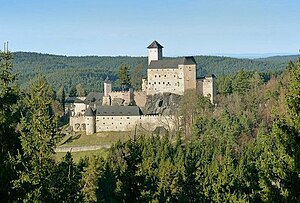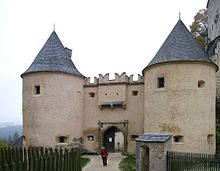Rappottenstein Castle
| Rappottenstein Castle | ||
|---|---|---|
| Creation time : | around 1150 | |
| Castle type : | Hilltop castle | |
| Geographical location | 48 ° 30 '43 " N , 15 ° 5' 17" E | |
| Height: | 701 m above sea level A. | |
|
|
||
The Rappottenstein Castle is a medieval castle in Rappottenstein in the northwest of Lower Austria . The Höhenburg was never conquered and is therefore one of the best preserved castles in Austria .
history
Around 1150 Rapoto von Kuenring founded a number of castles in the Waldviertel to secure the property of the Kuenringer , the most powerful of which was Rappottenstein.
Rappottenstein Castle was of great importance from the very beginning. On the one hand, it was located in the middle of the extensive holdings of the Kuenringer - so it was a stable center in a turbulent time. On the other hand, it also protected the Griessteig , an ancient branch of the Beheimsteig that can still be traced in the municipality today , which led from the Danube through the northern forest into the Bohemian countryside. In addition, Rappottenstein Castle was one of the strongest links in the chain of fortifications that was built on the course of the Kamp River , which had the task of protecting the country from invasions by the Bohemians and thus also providing flank protection for the Babenbergermark .
After the fall of the Kuenringer, the castle came to the Lords of Dachsberg in 1305, to the Starhemberg family in 1423 and to the Lords of Landau in 1546 . Insurgent farmers besieged the castle in 1597, but were unable to take it. Swedish troops also besieged the castle in vain in 1645.
Finally, in 1664, the castle was bought by the current owners, the Counts Abensperg-Traun , whose current properties are around Rappottenstein, near Wolkersdorf, near Maissau, in the Weinviertel, in the Waldviertel and in the industrial district, with Maissau and Petronell in particular .
architecture
The castle is one of the few that was never conquered and therefore never destroyed. It is a unique testimony to medieval fortifications with elements from Romanesque , Gothic and Renaissance styles :
- Romanesque : tower in the south
- Gothic : parts of the east wing, castle chapel, miners 'hall in the east wing, miners' kitchen and archive room
- Renaissance : brewery, arcades in the west wing, two towers at the entrance gate. As a rarity, these two towers have a double wardroom . Most of the castle's gates were once secured by drawbridges .
The brewery in the first courtyard has a few windows with sgraffito framing . The second gate was the main entrance until 1548. In the third courtyard are the farm buildings, a cistern and the legendary dungeon with the “hunger tower”. The inner courtyard is bordered in the west by three-storey Renaissance arcades, in the east and south by the Knappenhalle and in the north by the Knappenküche. In the east of the courtyard there are two late Gothic windows on the first floor. The “archive” has a Gothic star vault and frescoes from the “ Danube School ”.
To the north of the castle is a garden terrace with the clock tower with a pendulum clock. The striking thing about this watch is that it only has one hour hand. The weights are raised daily.
Castle chapel
The Gothic castle chapel was consecrated in 1379. It is two stories high and has walls three meters thick. There are twelve consecration crosses on the walls. The vault ribs rest on beautiful consoles. The winged altar dates from the 15th century and was restored in 1947.
Showpieces in other places
Some of the Rappottenstein Castle can be seen in other places today: For example, a ceiling, the two door panels and the Rappottenstein doors from around 1600 can be seen in the “Luisenzimmer” of the Franzensburg in Laxenburg .
Todays use
Under the name Kinderburg Rapottenstein , the Red Cross Lower Austria offers traumatized families support in the event of accidents or bereavement. The premises and the stables for the therapy animals are provided by the Abensperg and Traun family who own them.
On TV
In the program Die Burg - Prominent in chain mail on ProSieben , the viewers should be shown how people lived in a castle in the Middle Ages using the inner workings of Rappottenstein Castle. The show was moderated in 2005 by Sonya Kraus and Elton . Parts of the films Der Eisenhans , Die Wanderhure and Maximilian - The Game of Power and Love were filmed in the castle.
literature
- Castles, monasteries and chateaux regions Waldviertel, Danube region, South Bohemia, Vysočina, South Moravia ISBN 978-3-9502262-2-5 , p. 85 ff
Web links
- The castle and your masters
- Entry on Rapottenstein I in the scientific database " EBIDAT " of the European Castle Institute
- Entry about Burg Rappottenstein on Lower Austria Castles online - Institute for Reality Studies of the Middle Ages and Early Modern Times, University of Salzburg
- Entry via Rappottenstein to Burgen-Austria
- Entry for Rappottenstein Castle in the database of the state's memory of the history of Lower Austria ( Museum Niederösterreich )
- Entry on Rappottenstein Castle in the Austria Forum (in the Heimatlexikon)
- Photo gallery: Rappottenstein Castle
Individual evidence
- ^ Rappottenstein Castle
- ^ Rappottenstein Castle - History. In: burgenwelt.org. Retrieved June 9, 2020 .
- ↑ Rapottenstein Castle
- ↑ Tour of the Franzensburg. (No longer available online.) In: schloss-laxenburg.at. Archived from the original on January 20, 2012 ; accessed on May 20, 2020 .
- ↑ Children castle Rapottenstein. In: hospiz-noe.at. Accessed August 31, 2019 .
- ↑ "Maximilian: The Game of Power and Love" (AT): ORF / ZDF production with Niewöhner, Theret, Moretti, Anglade, Karl, Steinhauer and many more . OTS notification dated August 6, 2015, accessed February 1, 2017.



